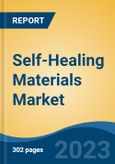Polymer is the fastest growing segment, Europe is the largest regional market
Speak directly to the analyst to clarify any post sales queries you may have.
10% Free customizationThis report comes with 10% free customization, enabling you to add data that meets your specific business needs.
Market expansion is primarily driven by rising demand for durable materials in automotive, aerospace, construction, and infrastructure sectors, along with sustainability goals that emphasize minimizing waste and extending material lifespans. However, growth is constrained by the high manufacturing and integration costs associated with these advanced materials. Positioned within the broader advanced materials sector, the market benefits from strong global momentum - Composites United e.V. reported that the global composites market reached 13.5 million tonnes in 2024, growing approximately 4% in 2023.
Key Market Drivers
Advancements in Material Science and R&D Investment
Continuous progress in polymer chemistry, nanotechnology, and composite engineering is a primary driver of the self-healing materials market. These innovations enable the development of materials that autonomously detect and repair structural damage, transitioning from conceptual science to practical solutions across diverse applications. Strong investment in research and development further accelerates this progress; BASF’s €2.1 billion R&D expenditure in 2024 exemplifies the industry’s commitment to advancing material performance and expanding self-healing capabilities.Key Market Challenges
High Manufacturing and Development Costs
A major challenge restraining market growth is the high production cost associated with self-healing materials. Their development requires specialized formulations, complex engineering, and advanced manufacturing infrastructure, resulting in significantly higher costs than traditional materials. These expenses elevate end-product pricing and hinder adoption, especially in cost-sensitive sectors. Additionally, the substantial financial requirements for innovation and scale-up limit participation by smaller enterprises. For example, the U.S. Department of Energy’s AMMTO allocated $2.1 million in FY 2023 for early-stage advanced materials projects, highlighting the high capital needs even at the initial development phase.Key Market Trends
Increasing Adoption of Self-Healing Coatings
A prominent trend shaping the market is the growing use of self-healing coatings, driven by their ability to extend product lifespan and reduce maintenance. These coatings repair minor damage autonomously and are rapidly transitioning into mainstream applications. The coatings sector’s strong economic performance reinforces this trend - European Coatings Journal reported that the top 25 European paint and coatings manufacturers generated nearly EUR 28.1 billion in 2023, up 4.8% from the previous year. Industry investment is also increasing, exemplified by Nippon Paint’s July 2025 launch of its n-SHIELD CrystalGuard self-healing paint protection film for automotive applications.Key Market Players Profiled:
- BASF SE
- The Dow Chemicals Company
- Wacker Chemie AG
- Covestro AG
- Huntsman International LLC
- NEI Corporation
- CompPair Technologies Ltd.
- Green-Basilisk BV
- Autonomic Materials, Inc.
- Applied Thin Films Inc.
- Acciona, S.A
- Evonik Industries AG
- Sensor Coating System Limited
Report Scope:
In this report, the Global Self-Healing Materials Market has been segmented into the following categories:By Form:
- Extrinsic
- Intrinsic
By Material Type:
- Polymer
- Concrete
- Coatings
- Others
By End Use:
- Building & Construction
- Mobile Devices
- Transportation
- Others
By Region:
- North America
- Europe
- Asia-Pacific
- South America
- Middle East & Africa
Competitive Landscape
Company Profiles: Detailed analysis of the major companies present in the Global Self-Healing Materials Market.Available Customizations:
With the given market data, the publisher offers customizations according to a company's specific needs. The following customization options are available for the report.Company Information
- Detailed analysis and profiling of additional market players (up to five).
This product will be delivered within 1-3 business days.
Table of Contents
Companies Mentioned
The companies profiled in this Self-Healing Materials market report include:- BASF SE
- The Dow Chemicals Company
- Wacker Chemie AG
- Covestro AG
- Huntsman International LLC
- NEI Corporation
- CompPair Technologies Ltd.
- Green-Basilisk BV
- Autonomic Materials, Inc.
- Applied Thin Films Inc.
- Acciona, S.A
- Evonik Industries AG
- Sensor Coating System Limited
Table Information
| Report Attribute | Details |
|---|---|
| No. of Pages | 185 |
| Published | November 2025 |
| Forecast Period | 2024 - 2030 |
| Estimated Market Value ( USD | $ 1.79 Billion |
| Forecasted Market Value ( USD | $ 3.04 Billion |
| Compound Annual Growth Rate | 9.2% |
| Regions Covered | Global |
| No. of Companies Mentioned | 14 |









